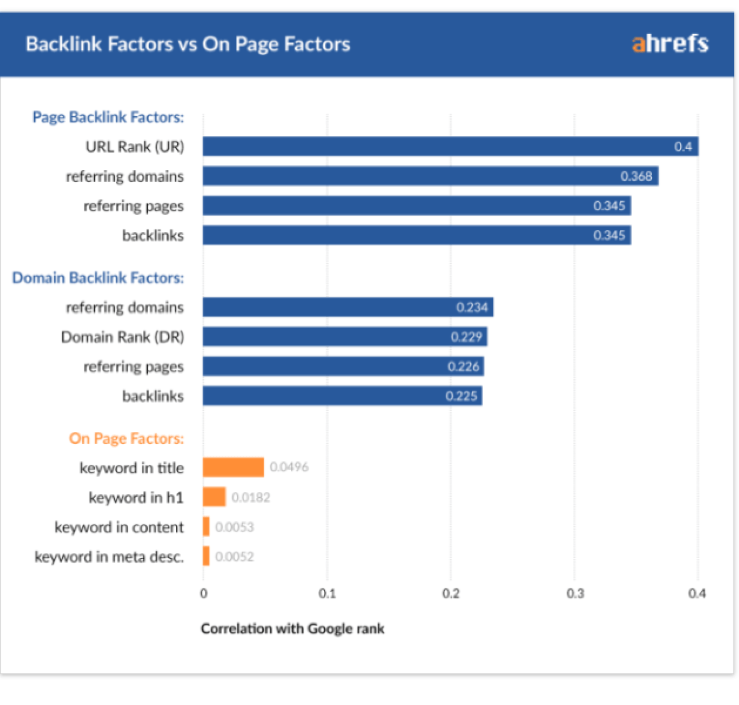An Essential Guide To SaaS Link Building (+Examples)
Link building is a crucial component of any successful SaaS (Software as a Service) marketing strategy. In this comprehensive guide, we’ll delve into the key strategies and provide real-world examples to help SaaS companies build a strong backlink profile and enhance their online presence.
1. Create High-Quality, Educational Content:
Example: Develop in-depth blog posts, case studies, and whitepapers that offer valuable insights into industry trends, best practices, and solutions.
2. Leverage SaaS Directories and Review Sites:
Example: List your SaaS product on reputable directories like Capterra, G2, and SoftwareAdvice, and encourage satisfied customers to leave positive reviews.
3. Guest Post on Industry-Relevant Blogs:
Example: Write guest articles for prominent SaaS blogs, sharing your expertise and providing actionable tips for readers.
4. Collaborate with Influencers and Thought Leaders:
Example: Partner with influencers in the SaaS space for webinars, podcasts, or co-authored content, and earn valuable backlinks from their platforms.
5. Participate in Industry Events and Webinars:
– Example: Host webinars or workshops showcasing your SaaS solution, and promote them through industry-related platforms for increased exposure.
6. Utilize Data-Driven Content for Authority:
Example: Conduct surveys or research studies in your industry, and publish data-driven reports that attract links from other businesses, bloggers, and journalists.
7. Create Engaging Infographics and Visual Content:
Example: Design visually appealing infographics that simplify complex concepts related to your SaaS product, making them highly shareable and link-worthy.
8. Develop Comprehensive User Guides and Tutorials:
Example: Craft detailed user guides, video tutorials, or how-to articles that demonstrate the full potential and functionalities of your SaaS solution.
9. Engage in Strategic PR and Outreach:
Example: Send press releases about significant product updates, partnerships, or achievements to industry-specific media outlets for potential coverage and backlinks.
10. Monitor Brand Mentions and Request Backlinks:
Example: Use tools to monitor brand mentions and reach out to websites that mention your SaaS product without linking, asking for proper attribution.
11. Share Valuable Insights on Social Media:
Example: Share industry insights, tips, and informative content on your social media channels, driving traffic and potential backlinks from engaged followers.
12. Collaborate with Complementary SaaS Solutions:
Example: Partner with complementary SaaS products for co-marketing initiatives, such as joint webinars or co-authored blog posts, resulting in mutual backlinks.
Conclusion:
By implementing these proven strategies and leveraging real-world examples, SaaS companies can establish a robust link-building foundation that not only boosts SEO but also strengthens their authority and credibility within the industry. Remember, consistency and quality are key to building a sustainable backlink profile for long-term success.
How to create a link building strategy
Creating an effective link-building strategy is essential for improving your website’s authority and search engine rankings. Here are steps to help you create a successful link-building strategy:
1. Set Clear Goals and Objectives:
Determine what you want to achieve with your link-building efforts. Whether it’s increasing organic traffic, improving search rankings, or boosting brand visibility, having clear goals will guide your strategy.
2. Understand Your Target Audience:
Identify your target audience and their interests. This knowledge will help you create content that resonates with them and attracts natural backlinks.
3. Conduct Competitor Analysis:
Analyze your competitors’ backlink profiles to identify potential link opportunities. Look for authoritative websites linking to them and explore if you can acquire similar links.
4. Create High-Quality, Relevant Content:
Develop compelling content that provides value to your audience. Quality content is more likely to attract natural backlinks from other websites.
5. Keyword Research:
Identify relevant keywords for your industry or niche. Incorporate these keywords naturally into your content to increase its visibility in search results.
6. Optimize On-Page SEO:
Ensure that your website’s on-page SEO is strong. This includes optimizing meta tags, headings, and image alt attributes to make your content more search engine-friendly.
7. Build Relationships with Influencers and Industry Experts:
Connect with influencers and experts in your industry. Collaborations can lead to natural backlinks when they share or reference your content.
8. Guest Posting:
Write high-quality guest posts for reputable websites within your niche. Include a link back to your website in the author bio or within the content (if relevant).
9. Utilize Social Media and Online Communities:
Share your content on social media platforms and participate in online communities relevant to your industry. This can lead to natural sharing and backlinking.
10. Outreach and Relationship Building:
Reach out to relevant websites, blogs, and influencers for potential link opportunities. Personalized outreach can lead to valuable backlinks.
11. Monitor Backlinks and Disavow Spammy Links:
Regularly monitor your backlink profile using tools like Google Search Console. Disavow any low-quality or spammy backlinks that could harm your site’s reputation.
12. Measure and Analyze Performance:
Track the performance of your link-building efforts. Monitor metrics like organic traffic, search rankings, and the number of acquired backlinks to assess the impact of your strategy.
13. Adapt and Refine Your Strategy:
Stay updated with industry trends and search engine algorithms. Adjust your link-building strategy as needed to ensure it remains effective over time.
Remember, patience is key in link building. Building high-quality backlinks takes time, but the long-term benefits for your website’s authority and search visibility are worth the effort.
Link building in 2023: 10 ways to win or fail
Link building remains a pivotal aspect of SEO, influencing a website’s authority and visibility in search engine rankings. In 2023, the landscape has evolved, demanding a refined approach. This guide explores ten effective strategies for successful link building, along with common pitfalls that can hinder your efforts.
Strategies for Success:
1. Quality Content Creation:
– Crafting high-quality, relevant content continues to be the cornerstone of successful link building. Engaging content naturally attracts links from authoritative sources.
2. Guest Posting with Purpose:
– Seek opportunities for guest posts on reputable websites within your industry. Focus on delivering valuable insights rather than simply aiming for a link.
3. Strategic Outreach and Relationship Building:
– Forge genuine connections with influencers and webmasters in your niche. Establishing relationships can lead to organic link placements.
4. Leveraging Social Media and Communities:
– Actively participate in relevant online communities and social media platforms. Sharing valuable content can lead to natural link acquisition.
5. Utilizing Data-Driven Content:
– Content enriched with data, statistics, and research findings tends to attract authoritative links. Conduct original research or provide unique insights to stand out.
6. Participating in Industry Events and Webinars:
– Actively engage in industry events, webinars, and conferences. Networking in these forums can lead to collaborative opportunities and valuable backlinks.
7. Monitoring and Reclaiming Lost Links:
– Regularly monitor your backlinks and address any lost or broken links. Reclaiming lost links can help maintain your website’s authority.
8. Utilizing Brand Mentions:
– Keep track of brand mentions across the web. Reach out to sources mentioning your brand without linking, and request a backlink for proper attribution.
9. Optimizing Internal Linking:
– Ensure that your website’s internal linking structure is well-organized and navigable. Proper internal linking enhances user experience and SEO.
10. Earning Reviews and Testimonials:
– Encourage satisfied customers to provide reviews and testimonials. These endorsements can lead to valuable links from review platforms.
Common Pitfalls to Avoid:
1. Overlooking Relevance:
– Acquiring links from irrelevant or low-quality sources can harm your website’s reputation and SEO efforts.
2. Ignoring Anchor Text Diversity:
– Over-optimized anchor text can trigger penalties. Maintain a natural mix of anchor text variations.
3. Neglecting Link Quality over Quantity:
– Prioritize quality over quantity. A few authoritative links hold more weight than numerous low-quality ones.
4. Engaging in Link Schemes or Black-Hat Tactics:
– Avoid shortcuts like link buying or participating in link schemes. These tactics can lead to severe penalties from search engines.
5. Failing to Diversify Link Sources:
– Relying solely on one type of link-building strategy can be limiting. Diversify your approach to maximize results.
Conclusion:
In 2023, a thoughtful and multifaceted approach to link building is essential. By implementing these strategies and avoiding common pitfalls, you can foster a robust backlink profile that strengthens your website’s authority and rankings in search results.
Best link building strategies
Link building remains a cornerstone of effective search engine optimization (SEO) strategies. However, in an ever-evolving digital landscape, it’s imperative to implement tactics that not only build links but also contribute to long-term SEO success. In this comprehensive guide, we’ll explore the best link building strategies that can propel your website to the top of search engine results pages (SERPs) and establish authority in your niche.
I. Create High-Quality, Shareable Content
1. In-Depth Guides and Resources:
– Craft comprehensive, informative content that serves as a valuable resource for your audience. This encourages organic linking from other websites.
2. Infographics and Visual Content:
– Visual assets like infographics can attract more shares and backlinks, especially when they convey complex information in an easily digestible format.
II. Guest Blogging and Contributorship
1. Target Reputable Publications:
– Identify authoritative websites and industry publications that accept guest contributions. Contribute valuable content to these platforms with a backlink to your site.
2. Establish Relationships:
– Build relationships with editors, fellow contributors, and influencers in your industry. Networking can lead to more guest blogging opportunities and collaborations.
III. Broken Link Building
1. Identify Relevant Broken Links:
– Find broken links on reputable websites within your niche. Tools like Check My Links and Ahrefs can assist in this process.
2. Offer a Relevant Replacement:
– Reach out to the website owner or editor, and suggest your content as a suitable replacement for the broken link. Ensure your content adds value to their page.
IV. Skyscraper Technique
1. Identify Link-Worthy Content:
– Find high-performing content in your niche that has garnered numerous backlinks. Tools like BuzzSumo can help with this research.
2. Create Even Better Content:
– Develop a piece of content that surpasses the quality, depth, and value of the original. Promote it to the websites linking to the original content.
V. Collaborate with Influencers and Thought Leaders
1. Expert Roundups:
– Conduct expert roundups or interviews with influencers in your industry. When published, these influencers are likely to share the content, generating backlinks.
2. Co-Create Content:
– Collaborate on content projects, such as ebooks, webinars, or podcasts, with influencers. These collaborations can result in valuable backlinks from their audience.
Effective link building is a dynamic process that requires a combination of strategies tailored to your specific industry and audience. By creating high-quality content, leveraging guest blogging opportunities, capitalizing on broken link building, implementing the skyscraper technique, and collaborating with influencers, you can establish a robust link profile that not only boosts your SEO but also establishes your authority in your niche. Remember, patience and persistence are key; the rewards of a well-executed link building campaign often manifest over time.
Which links move the needle?
Introduction
In the dynamic realm of digital marketing, not all links are created equal. Some have the power to significantly impact a website’s visibility, traffic, and authority, while others may have minimal influence. Understanding which links “move the needle” is crucial for a successful SEO strategy. In this comprehensive guide, we will delve into the types of links that truly matter and how they contribute to your website’s online presence.
I. High-Quality Backlinks: The Backbone of SEO
1. Authoritative Domains:
– Links from websites with high domain authority are highly valuable. They signal to search engines that your content is trusted and relevant.
2. Relevance:
– Backlinks from websites in the same industry or niche are considered more valuable. They provide context and relevance to your content.
3. Editorial and Natural Links:
– Links that are naturally included in content by publishers are more impactful than those obtained through manipulative tactics.
II. Guest Posts and Contributed Content
1. Strategic Guest Blogging:
– Contributing high-quality, informative content to reputable websites in your industry not only builds backlinks but also establishes your authority and expertise.
2. Author Bios and In-Content Links:
– Within guest posts, links in the author bio and content itself can lead to increased visibility and traffic for your website.
III. Social Signals and Brand Mentions
1. Social Media Engagement:
– While not direct backlinks, social signals such as shares, likes, and comments can indirectly influence search rankings.
2. Brand Mentions:
– Being mentioned or cited on reputable websites, even without a clickable link, contributes to your brand’s authority and credibility.
IV. Internal Links: Strengthening Site Architecture
1. Relevance and Anchor Text:
– Internal links with relevant anchor text help search engines understand the content and context of pages within your site.
2. User Experience and Navigation:
– Well-structured internal linking improves user experience by guiding visitors to related content and providing clear navigation paths.
V. Local Citations and Niche Directories
1. Local SEO Citations:
– Listings in local directories and platforms like Google My Business are crucial for businesses targeting local audiences.
2. Niche-Specific Directories:
– Being listed in industry-specific directories can boost your authority within your niche and improve visibility among relevant audiences.
In the ever-evolving landscape of SEO, understanding the impact of different types of links is paramount. High-quality backlinks, guest posts, social signals, internal links, and local citations all play a pivotal role in improving your website’s visibility and authority. By strategically acquiring and utilizing these links, you can effectively move the needle and position your website for success in the competitive online marketplace. Remember, it’s not just about the quantity of links, but the quality and relevance that truly make a difference.
Google: We Don’t Use Links On YouTube For Search
Google did not use traditional external links (backlinks) as a primary ranking factor for videos on YouTube within its search algorithms. However, YouTube employs a variety of other factors to rank and recommend videos to users on its platform. Here are some key points to consider:
1. Engagement Metrics: YouTube places a strong emphasis on user engagement metrics, such as watch time, likes, dislikes, comments, and shares. Videos that generate high user engagement are more likely to be recommended and rank well.
2. Relevance: Video content should be relevant to user queries and interests. Titles, descriptions, and tags play a significant role in conveying the content’s relevance to both YouTube and Google search algorithms.
3. User Behavior: User behavior on YouTube, including click-through rates (CTR) from search results and related videos, can influence ranking. High CTR and user interaction signal to YouTube that a video is relevant and engaging.
4. Video Metadata: Properly optimizing video metadata (titles, descriptions, tags) with relevant keywords and descriptions can improve discoverability in search results.
5. Closed Captions and Transcripts: Providing accurate closed captions and transcripts for videos can enhance accessibility and improve search visibility, as they provide additional textual content for search engines to index.
6. Channel Authority: YouTube considers the overall authority of a channel when ranking its videos. Channels with a history of high-quality content and engaged audiences may receive a ranking boost.
7. Content Quality: The quality of the video content itself, including production value, informative content, and viewer retention, can impact how well it ranks and is recommended.
It’s important to note that while external backlinks are not a primary factor in YouTube’s ranking algorithm, they can indirectly influence video visibility. For example, sharing video links on social media or other websites can drive traffic and user engagement, which can positively affect a video’s performance and ranking.
Keep in mind that Google’s search and YouTube’s internal search algorithms may evolve over time. Therefore, it’s a good practice to stay updated with the latest information and best practices for optimizing videos on YouTube for search visibility and user engagement.
How to build authoritative links with data-driven content
Building authoritative links with data-driven content involves creating high-quality, informative content that is backed by credible data and statistics. Such content not only attracts attention from other websites and users but also provides valuable information that others are more likely to link to. Here’s a step-by-step guide on how to do it effectively:
1. Identify a Relevant Topic:
– Choose a topic that aligns with your industry, target audience, and the type of data you have access to or can collect.
2. Collect Reliable Data:
– Gather data from credible sources, conduct surveys, or analyze relevant studies. Ensure that your data is accurate, up-to-date, and from reputable sources.
3. Create Data-Driven Content:
– Develop your content around the data you’ve collected. This could be in the form of infographics, charts, graphs, case studies, reports, or whitepapers.
4. Add Context and Analysis:
– Provide insights and analysis of the data you’ve collected. Explain why the data is important, what trends or patterns it reveals, and how it impacts your industry or audience.
5. Craft a Strong Headline:
– Create a compelling and intriguing headline that highlights the value of your data-driven content.
6. Design Visuals:
– If applicable, create visually appealing and informative graphics to present your data. Visuals make the content more engaging and shareable.
7. Publish on Your Website:
– Publish the data-driven content on your website’s blog or resource section. Ensure that the content is easily accessible, mobile-friendly, and well-organized.
8. Promote on Social Media:
– Share your content on social media platforms to increase its visibility. Consider using quotes or key findings as teaser posts.
9. Outreach to Relevant Websites:
– Identify authoritative websites, blogs, and influencers in your industry. Reach out to them with a personalized pitch, explaining how your data-driven content could be valuable to their audience.
10. Email Outreach:
– Send targeted outreach emails to individuals or organizations that could benefit from or be interested in your data. Include a brief summary and a link to your content.
11. Engage in Online Communities:
– Participate in forums, discussion boards, and relevant online communities. When appropriate, share your content as a valuable resource.
12. Collaborate with Influencers:
– Partner with influencers in your industry who can help amplify your content to a wider audience.
13. Press Releases:
– If your data-driven content is particularly groundbreaking, consider issuing a press release to gain media coverage and authoritative backlinks.
14. Monitor and Build Relationships:
– Keep track of who links to your content and engage with them. Building relationships can lead to more future collaborations.
15. Measure Results:
– Use tools like Google Analytics to track the performance of your data-driven content. Monitor traffic, engagement, and the number of authoritative backlinks generated.
Remember, the key to success with data-driven content is not just in presenting data but in providing valuable insights and actionable takeaways. By delivering high-quality, informative, and well-researched content, you increase the likelihood of attracting authoritative links and establishing your website as a trusted source in your industry.
11 SEO Link Building Techniques
Certainly, here are 11 SEO link building techniques that can help improve your website’s search engine rankings and authority. Remember that while link building is important, quality and relevance are key factors in ensuring its effectiveness:
1. Guest Blogging: Write high-quality guest posts for reputable websites in your industry. Include a relevant link back to your site within the content or author bio.
2. Broken Link Building: Identify broken links on relevant websites and offer your own content as a replacement. This can be a mutually beneficial approach.
3. Skyscraper Technique: Create exceptional, comprehensive content that’s better than existing resources. Reach out to websites linking to similar content and suggest they link to your improved version.
4. Resource Page Link Building: Find resource pages related to your niche and suggest your content as a valuable addition. Make sure your content genuinely adds value to the page.
5. Infographics: Create informative and visually appealing infographics and share them on your website. Encourage others to embed your infographics on their sites, linking back to you.
6. Outreach and Relationship Building: Reach out to influencers, bloggers, and websites in your industry. Build genuine relationships and ask for opportunities to collaborate or contribute.
7. Content Promotion: Promote your high-quality content through social media, forums, and communities. When others find your content valuable, they might naturally link to it.
8. Interviews and Expert Roundups: Conduct interviews with experts in your field or participate in expert roundups. When the content is published, you’ll often receive backlinks from participants.
9. Local Business Directories: List your business in reputable local directories and industry-specific directories. Ensure your information is consistent across all listings.
10. Social Media Profiles: Include your website link in your social media profiles. While these are nofollow links, they can still drive traffic and visibility.
11. Ego Bait: Create content that features or highlights influencers, companies, or websites in your industry. When you mention them, they might share or link to your content.
Remember, the key to successful link building is to focus on quality over quantity. Build links from authoritative and relevant sources, and avoid engaging in spammy or manipulative practices that could lead to penalties from search engines. Additionally, always ensure that the content you’re linking to is valuable and relevant to the audience you’re targeting.
Mastering SEO Link Building: 8+ Simple Tips for Success
In the dynamic world of Search Engine Optimization (SEO), link building remains a fundamental strategy to boost your website’s authority and rankings. While it may seem intricate, mastering SEO link building can be achieved through a combination of simple yet effective techniques. This guide presents a collection of straightforward tips to help you navigate the art of link building and enhance your website’s online presence.
1. High-Quality Content Creation: The Foundation of Link Building
Creating valuable and informative content naturally attracts backlinks from authoritative sources. Focus on producing content that addresses your audience’s needs and offers unique insights.
2. Guest Posting: Forge Partnerships and Build Links
Contribute guest posts to reputable websites within your niche. By sharing your expertise, you not only gain exposure but also earn valuable backlinks to your website.
3. Manual Outreach: Build Relationships and Earn Backlinks
Reach out to other website owners, bloggers, and influencers in your industry. Building genuine relationships can lead to backlink opportunities through collaboration.
4. Broken Link Building: Turn Errors into Opportunities
Identify broken links on relevant websites and offer your content as a replacement. This method provides value to website owners while earning you valuable backlinks.
5. Skyscraper Technique: Elevate Your Content
Identify popular content in your niche, create something even more valuable, and then reach out to websites that are linked to the original content, offering them your improved version.
6. Resource Link Building: Position Yourself as a Resource
Create comprehensive guides, infographics, or tools that are useful to your target audience. Other websites may naturally link to these resources, establishing your website as a valuable reference.
7. Internal Linking: Harness the Power Within
Utilize internal links to connect related content within your website. This enhances user experience and helps search engines understand your content’s structure.
8. Social Media Promotion: Amplify Your Content
Promote your content on social media platforms to increase its visibility. When your content gains traction, it’s more likely to be shared and linked by others.
9. Earning Backlinks through Relationships: Networking Pays Off
Building relationships with industry peers, bloggers, and influencers can lead to natural backlink opportunities as they recognize your expertise.
10. Directory Submissions: Choose Reputable Directories
Submit your website to high-quality, relevant directories. Be selective and opt for directories that are trusted and reputable within your niche.
Mastering SEO link building doesn’t have to be daunting. By implementing these simple yet effective techniques, you can enhance your website’s authority, visibility, and search engine rankings. Remember, the key is to focus on creating valuable content, fostering relationships, and strategically promoting your website to earn high-quality backlinks that will contribute to your online success.
Link Building for SEO: A Comprehensive Beginner’s Guide
In the realm of Search Engine Optimization (SEO), link building holds a central role in boosting a website’s visibility, authority, and rankings. For beginners venturing into the world of SEO, understanding the nuances of link building is essential. This comprehensive guide provides a step-by-step introduction to link building, its significance, strategies, and how it contributes to enhancing your website’s online presence.
The Importance of Link Building in SEO
1. Building Digital Bridges: Links serve as connections between different web pages, facilitating navigation and helping search engines discover content.
2. Enhancing Authority: High-quality backlinks from authoritative websites signal to search engines that your content is valuable and trustworthy.
Link Building Strategies for Beginners
1. Quality over Quantity:
– Focus on obtaining high-quality backlinks from reputable websites rather than pursuing a large quantity of low-quality links.
2. Content Creation and Promotion:
– Craft compelling and valuable content that naturally attracts links from other websites in your niche.
Types of Link Building
1. Natural Links:
– Earned through the merit of your content, these are the most valuable and sustainable links.
2. Manual Outreach:
– Actively reach out to other website owners, bloggers, and influencers to request backlinks to your content.
3. Guest Posting:
– Contribute high-quality articles to other websites in exchange for a backlink to your own site.
4. Social Media and Forums:
– Participate in relevant online communities to share your expertise and attract natural backlinks.
Link Quality and Relevance
1. Relevance Matters:
– Aim for backlinks from websites that are relevant to your industry or content niche.
2. Diverse Anchor Text:
– Use a variety of anchor text to ensure natural linking patterns and avoid over-optimization.
Avoiding Link Building Pitfalls
1. Avoid Paid Links:
– Google penalizes websites for using paid links that manipulate search rankings.
2. Steer Clear of Link Farms:
– Refrain from participating in link schemes or link exchange networks that can harm your website’s credibility.
Measuring Link Building Success
1. Google Search Console:
– Monitor your website’s backlink profile and track new links using Google Search Console.
2. Backlink Analysis Tools:
– Utilize tools like Ahrefs, Moz, and SEMrush to gain insights into your backlink profile and track competitor backlinks.
The Future of Link Building
1. Quality Continues to Prevail:
– Search engines will increasingly prioritize high-quality, contextually relevant backlinks.
2. Focus on E-A-T:
– Expertise, Authoritativeness, and Trustworthiness will remain critical factors in link evaluation.
Link building is a cornerstone of effective SEO, but it’s not about chasing after numerous links. Instead, it’s about cultivating meaningful relationships with other websites and providing value to your audience. As a beginner, understanding the basics of link building, focusing on quality and relevance, and avoiding common pitfalls will set you on the path to establishing a strong online presence, enhancing your website’s authority, and ultimately achieving improved search engine rankings.













